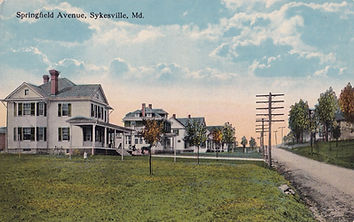Sykesville History

Axe head found on an Eldersburg area farm, undated. Found c. 1960-1970.

Bloomfield Farm as viewed from the Sykesville Linear trail, also showing a contemporary springhouse. The original farmhouse dates to the early 1800s, and was at one time the property of James Sykes.

Postcard of Springfield Avenue postmarked 1917.

For more than a century, access to transportation, pastoral hills, and an active small-town community have defined Sykesville. Archeological evidence shows that, before the homes, farms, mills, and mines, Sykesville’s hills and waterways hosted Native American hunting and trading sites frequented by the Susquehannock, Piscataway, and centuries-older unnamed groups. By the Revolutionary War, these same fields filled with busy, muddy highways and roads which passed through early farms and neighborhoods of the area, including the village of Eldersburg.
James Sykes, an English immigrant, worked with wealthy and prosperous George Patterson. The Patterson family owned a substantial property known as “Springfield” where Springfield Hospital Center is today. From the edges of this property, Patterson sold Sykes much of the area that surrounds Main Street today including land adjacent to the B&O railway line which would soon reach the area.
As the second stop on the B&O line in 1831, Sykesville became an ideal location for wealthy landowners to escape the city of Baltimore. From June through August, the tourism trade served as extra income for area households who rented out spare rooms to accommodate these guests. Alongside these visitors, the trains also brought in railway workers and new permanent residents who saw the promise of a town in the making.
As the river powered industry and the rails heralded new visitors, the flood of 1868 served to permanently reshape the village. After this flood, the railway was reconfigured, and the washed-out businesses once located South of the river moved up the hill along Main Street in much the same formation as they appear today. As the town rebuilt, department stores, lunch counters and a movie theater joined the ranks of Main Street businesses.
The further development of Main Street, including the installation of electric street lights, followed the Town’s 1904 incorporation. Around this time, J.H. Fowble designed and oversaw construction of many of Sykesville’s notable buildings and homes such as the Warfield Building and the Sykesville Town House. The town grew until factors outside of local control contributed to a decline in prosperity.
Two world wars, the end of passenger rail service (1949), the redirection of traffic from Main Street to Route 32 (1964), and devastating flooding from Hurricane Agnes (1972) compounded national economic troubles which worsened in the 1970s and 80s.
Through the efforts of citizens, and especially the collaboration of the Main Street businesses, Sykesville saved many of its historical structures, reinvented itself as The Coolest Small Town with the Best Main Street in America, and rejuvenated itself as the center of activity you see today.
Main Street businesses at the Warfield Buildings
photo taken summer 2023.